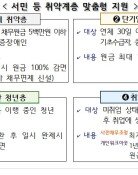Humane and Warm-Hearted
When cutting-edge technology and humanity meet
The 1324 (aged 13 to 24) Generation is familiar with cold, mechanic digital culture because they have been exposed to the Internet environment since birth.
It was analyzed that this generation is creating a new culture that values more humanity and analogue-sensitivity than the existing generation does.
Cheil Communications published a report yesterday titled: A Different Era under Creation by Digital Culture, and its Main Players, which is an in-depth study on peoples attitudes facing social changes based on a survey of 800 males and females aged between 13 and 49 who live in Seoul. The report prescribed the 1324 Generation as the PDG (Post Digital Generation), which has different characteristics compared with others.
PDG: A New Digital Generation that Values Human Values-
The report analyzed that the PDG constituents are middle, high school, and university students aged 13 to 24 who have different inclinations compared with other generations. Although they grew up in a cold, mechanical digital environment, they possess analogue-sensitivity, subjectivity, and optimism.
The report added that they broke the frontier between the on-line and off-line worlds, and are breaking away from the isolated individual syndrome, a symptom that appeared in the early stages of the digital era.
It attributed the success of Cyworlds mini-hompy service, which hit 110 billion won in sales last year, to the PDGs characteristic of wanting to make on-line human connections similar to those in the real world.
Not All PDG Constituents are the Same-
The nucleus of the PDG is the 1618 Generation (those who are 16 to 18 years old) who were born after 1986. This is the generation who lived their elementary school days in an Internet-popularized era, making use of digital equipment and culture freely.
In contrast, the 1924 Generation made up of those who were born after 1980 is classified as generation who experienced networking through computer communications systems like Hitel and Chollian before the Internet became popular in earnest. They are evaluated as less familiar with digital appliances and culture than the 1618 Generations is. Cheil Communications analyzed that the 1315 Generation born after 1989 is not a major consumption group since they still lack independent consumption power.
Emerging as Rational Consumers-
The PDG has a high propensity to make impulsive purchases of the goods that they want to possess. Nonetheless, they display a Janus consumption behavior, or the propensity to make planned purchases, in which they actively use discount benefits via coupons and discount cards.
Those who responded that they buy what they really want once they feel the urge accounted for 44.3 percent of those surveyed, while those who responded that they actively take advantage of discount benefits accounted for 58.2 percent.
Coming up with a keyword to attribute to them, the report suggested H.E.A.R.T.S: H (Human Relationships), for their digital human relationships; E (Expressionism), for their digital expression; A (Anti-literality), for their visual lifestyle; R (Relaxed Mindset), for their optimistic life style; T (Trend-independence), for their subjective reception of trends; and S (Speed), for their promptness.
Vice Director Lee Ju-hyun of Cheil Communications brand marketing institute said, The PDG has a rational and humane face, showing attachment to humane sentiment and boldness against failures. You can say that they are a digital generation with a human face.
Jin-Hup Song Hyo-Lim Son jinhup@donga.comaryssong@donga.com






